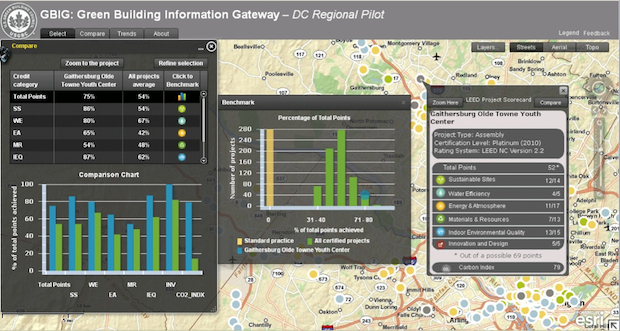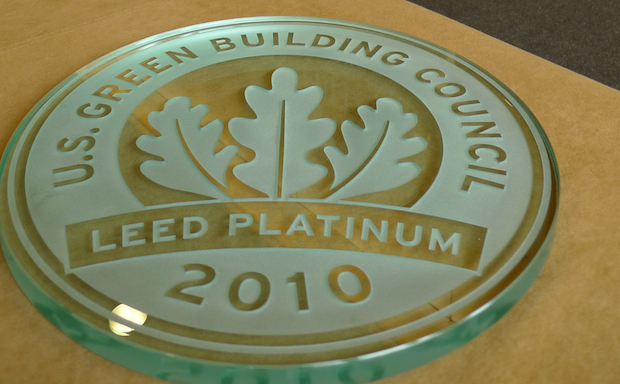
If you’re paying attention, you no doubt have seen the plaques placed near the doors of major new commercial buildings, announcing an impressive LEED rating. For building owners, in this real estate cycle and all those that will follow it, a good LEED rating shows that you're thinking about the planet. And for renters, it shows that your landlord is working to reduce costs and make the workplace more healthy. Everyone wins. But what does your skyscraper’s gold or platinum LEED rating really mean?
While LEED ratings have increased in public consciousness (with 1.5 million 6.8 billion square feet of commercial space certified since 2000), there has been way too little transparency about how new buildings with high LEED scores actually perform. So, while the marketing excitement of a platinum rating may score some points, it can hit a dead end under scrutiny. Some engineers, for instance, complained that LEED points were too easy to rack up in an incoherent building: Many cited the fact that a bike rack earned points in a building that might have a faulty boiler. And landlords faced no penalty if they declined make improvements or even use the technology they installed once given a rating by LEED. At its weakest, a LEED certification amounted to a one-time endorsement of a building’s design, with no follow-up.
Now, though, the system is changing--from within--to better reflect how LEED buildings actually save energy and water and how they can improve.
The nonprofit United States Green Building Council (USGBC), which administers LEED, says its volunteer members want to think of green buildings as assets rather than as checkoffs. The latest version of the building-rating system, called LEED 2012--which will launch in November and the go to USGBC members for a vote in November next summer--takes advantage of new technology and building practices that make real-time energy and water management commercially viable. Sharing this data so that other commercial real estate owners can compare their energy use is now going to be required. “Our goal is to show that real leaders share data,” says Scot Horst, USGBC’s Senior VP for LEED. LEED 2012 will also require owners to recertify every five years. So if you invest in a LEED rating when you open, you’ll have to prove over time that you’re staying current with available energy-saving techniques.
To get all the data from buildings ready for public consumption, the USGBC is inviting software developers to make that data legible. Horst showed Fast Company a preview of LEED 2012 in the Council’s airy headquarters in the heart of Washington, D.C. Using a database called the Green Building Information Gateway, the software allows an owner to tap into comparable data from similar buildings.

“I think of it like the Zagat rating,” says Horst. “Everyone will see the [LEED] plaque, but customers will go to the building with the current year on the plaque.” Presumably a “LEED 2011” plaque will look as cutting-edge in 2017 as a bike rack looks now.
LEED scores actually come from many separate tests, though the general public tends to pay attention only to the LEED-New Construction exam. For landlords who have earned certification under LEED for Existing Buildings’ Operations and Maintenance (or “ee-bomb”), these reporting requirements are not so new. Indeed, Horst says, LEED has certified more existing buildings than new ones--though new ones tend to draw both hype and suspicion.
For every other kind of landlord, the new rules create a stiff marketing challenge. Horst readily acknowledges that some owners have gotten used to patching together credits in order to lure tenants (the bike rack problem) but he argues that the market has evolved too far for this to continue. “Now the LEED rating is the beginning of a relationship,” says Horst, before offering an analogy: “If I leave the church [after getting married] and then I’m a pain in the ass, my wife is not going to stay with me.” Likewise, he hopes, tenants in the current marketplace will not stay with a landlord who can’t keep up with best practices in energy management.
Using LEED 2012, owners can keep an eye on performance with new apps available on LEED Online. It’s not clear that a full dashboard will be ready when the program launches next year, but the stockpile of apps will make actual performance--rather than just the components--easier to compare. (One potential app for sale maps energy-sucking boilers near the end of their useful lives.) “Faster, cheaper, more automatic” is LEED’s mantra for its new system, which is now open for a second wave of public comment. Software vendors would post the apps in exchange for the right to sell beefed-up versions of these tools to building owners.

According to Horst, more than 30 companies are developing tools with USGBC to help owners track and fix buildings’ performance. Some silently monitor equipment such as boilers to pinpoint areas of failure. Others consolidate information from different parts of a building.
“The apps area will be a place where you can see what the market is doing about LEED,” says Horst. “Some may tell a story about LEED, some may connect to LEED. The idea is that each LEED point creates an opportunity for automation, whether it’s in tracking your waste or something else.”
The timing of LEED 2012 is intelligent--New York and San Francisco are starting to mandate retrofits of older buildings, and tuning them up is a lot more cost-effective than wrecking them. While some skeptics might smell an attempt to brush back upstart systems like the more stringent (and so far, all but impossible to meet) Living Building Challenge, USGBC executives say the new focus on performance data matches how forward-thinking landlords are using LEED. “A great deal of what’s happening in green building comes from our own projects,” says Chris Pyke, USGBC’s verbally adept VP of research. “The goal of getting the data online is to enable owners to compete with each other.”
Pyke imagines an energy manager trying to make the case for investment in electric meters to her executive committee. “When they ask: ‘What’s the return on investment of that meter?’ Umm… a meter doesn’t have a return on investment! The things you do with that meter do.” Those things include turning lights off when you leave a room, using shared controls for A/C, and other rules that are less photogenic than (to use Pyke’s examples) “a solar hot water heater or a light bulb.”
The booming energy-services industry, led by huge companies that manage customers’ whole unruly mix of boilers and A/Cs and overhead lights for a fee, is predictably cheering on the change. Jeff Drees, U.S. president for $27 billion Schneider Electric, says he hopes landlords will now get LEED credit for syncing choices about design, fuel, operations, and maintenance into a single online dashboard. “No longer does a bike rack get credit over an integrated process,” says Drees.
The promise of new software tools means a new metric for how real estate owners price and trade their assets. This will only fly if real estate owners resign themselves to disclosure--which is perhaps why Horst talks so urgently about making data-gathering fast and automatic wherever possible.

Of course, when the government made managers of stocks and bonds disclose performance, the managers came up with zippy ways of hiding the facts. Why should landlords be any more forthcoming?
Pyke argues that landlords will see energy-performance disclosure as a way to create value. “The average [building owner] is still sitting there with spreadsheets and utility bills, maybe getting automated bills and exporting them into Excel,” he says. “There is a huge market for automation partners and I hope that we don’t know who those are yet.”
A database with real building performance, searchable and scalable, can make for frothy competition among secretive landlords. Can it also make for smarter energy management? Horst is careful not to predict the performance criteria for recertification before the comment period ends-perhaps because he wants to make sure to pick ones that tie to visible financial benefits.
“It’s very early days,” Horst says. “The idea is that over time there will be a number of applications and activities that we could never do ourselves.”
